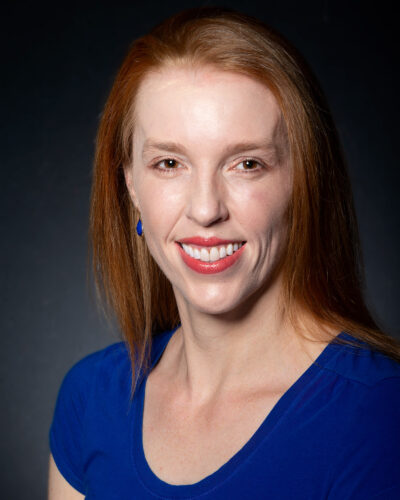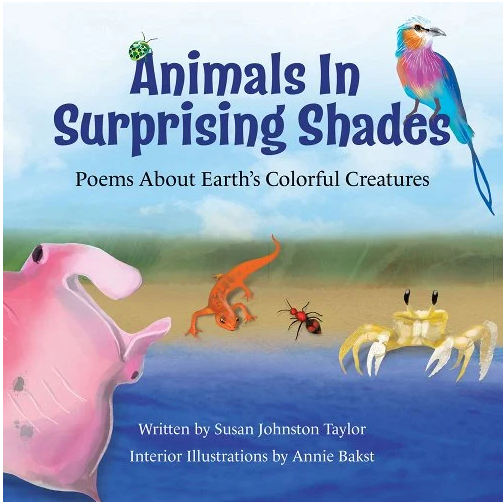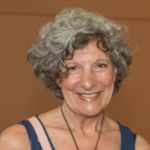Working as a freelance business and personal finance writer isn’t the likeliest path to becoming a children’s book author.
Unlikely, but not impossible. In 2016, Susan Johnston Taylor was burned out from a decade of freelancing and craved a different outlet for her creative skills. On a whim, she wrote a picture book about her dog. It wasn’t a viable premise for a book. But it did inspire her to learn more about writing children’s books.

Flash forward seven years. After getting her feet wet writing work-for-hire kids’ books, Johnston Taylor published her first children’s book with a traditional publisher in 2023. Animals in Surprising Shades: Poems About Earth’s Colorful Creatures combines science with poetry to depict a rainbow collection of creatures from around the world.
The book earned multiple accolades, including as an outstanding science trade book for students K-12 by the National Science Teaching Association (NSTA) and the Children’s Book Council (CBC), and a teacher favorite for 3rd-5th graders on the Children’s Book Council’s annual list. It’s also nominated for a 2024-2025 Keystone to Reading Elementary Book Award (Elementary Division) with the Keystone State Literacy Association. Most recently, it helped Johnston Taylor land a literary agent, her first.
In an email interview, she discussed her big pivot, the children’s book market, starting over in a new genre, and how ASJA has supported her career. Her comments have been edited for length and clarity.
How long have you been freelancing?
I’ve been freelancing since about 2004, and full time since 2008. For a long time, I focused on personal finance and small business. I still take some assignments here and there to supplement my other work, but I’m not pitching nearly as much as I once did.
Writing for kids was a big pivot. When and how did that happen?
Around 2016, I started to feel burnt out on business and personal finance. I questioned how much more I had to say about mortgages or insurance. My husband urged me to try writing something–anything–else, so I said the first thing that popped into my head, “Maybe I’ll write a picture book about Sebastian,” our rescue dog.
It seemed outlandish, because it was so different from the writing I’d been doing, but he encouraged me to explore the idea. I drafted a sweet story, but that manuscript wasn’t a saleable book premise. However, it started me on a journey to learning about children’s books and becoming a children’s book author. That was just one of many gifts Sebastian gave me before he passed recently.
You only recently got a literary agent. How did you publish your first children’s books without one?
My first several books were work-for-hire projects for educational publishers, where they give you the project specs, such as word count, topic, and grade level. Work-for-hire is different from writing a book for a traditional or “trade” publisher that sells to bookstores and other consumer channels (not exclusively; they may also sell to schools and libraries). Educational publishers mostly focus on the school and library market, so you don’t usually see those books in bookstores.

Animals in Surprising Shades resulted from a direct submission to a new small press called Gnome Road Publishing. Since I didn’t have an agent, I had a lawyer friend look over the contract. It was a bit of a gamble, because mine was one of the very first books Gnome Road released, but it’s paid off. They’ve been great to work with and continue supporting my book even as they release new titles.
Where did you come up with this idea?
Reading about the Malabar giant squirrels in India sparked my curiosity about other animals in unusual colors. I’ve read several of Jane Yolen’s STEM poetry collections about animals, so I thought I’d try writing my own poetry collection, with the animals presented in rainbow order.
How did you promote it?
This was my trade debut so I wanted it to do well. I think a lot of debut authors try to do all the things, and I was no exception. I set up readings and signings at any bookstore or venue that would have me, including setting up events in other states while I was traveling. I posted on social media.
I also joined three book marketing groups: PB Spree, STEAM Team and Green PB 2023. Book marketing groups aren’t new, but I found them hugely valuable during my debut year. We set up joint giveaways and other promotions online, brainstormed marketing ideas, commiserated over challenges or disappointments, critiqued other projects we were working on, and just generally helped support each other’s books.
Are fees and contracts for children’s books similar to those for adult books?
My experience with children’s trade books is that those deals are structured similarly, with an advance and royalty. My educational books paid a flat fee with no royalties.
How did you land an agent?
I found my agent, Mara Cobb at Martin Literary Management, through a cold submission. She liked my writing and asked to set up a Zoom meeting. We “met” the next morning, and she offered to represent me on the spot!
How long have you been in ASJA, and how has the organization supported you?
I believe I joined back in 2009. I have attended several New York City conferences and landed assignments through Client Connections. In fact, one year I didn’t get a meeting with a Parade Magazine editor, so I emailed immediately after the conference to say, “We didn’t get to meet at the ASJA conference but here’s a story idea.” They bought it and even paid for me to travel to Chicago on assignment!
I’ve also gotten and given referrals to other members, so it’s been great for networking and support.
What would you tell writers about getting into kids’ books or doing their own big pivot?
For getting into kids’ books, read as many recently published books as you can to understand what’s already been published and expectations of the genre. Someone once told me that you should try to read 1,000 picture books before you try writing one. Picture books specifically trend towards much shorter word counts than the books many of us read growing up, often 500 words or less for fiction. Plus, there are tons of new books published every year, so you need to know the market and be able to articulate how yours is different.
For doing a big pivot, you have to be willing to be humbled. When I started writing picture books, I assumed I’d land an agent and get published fairly quickly, because I was already writing professionally in other spaces. It definitely didn’t happen for me overnight. There were a lot of things I still needed to learn, like how to leave room for the illustrator, and how to give the child protagonist agency. I already had a good grasp of grammar, word play, and dialogue, but other authors are teachers, librarians, and parents, so they have kid knowledge I needed to acquire.
Michelle Rafter is a ghostwriter and ASJA member in Portland, Oregon. She is ASJA’s publications chair, on the 2024-2025 conference planning committee, and ran the organization’s 2023 virtual annual conference.
Browse Articles
Topic
Book Publishing, Craft & Writing Skills, Freelance Life, Writing Skills

